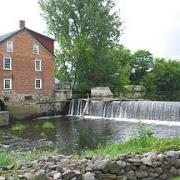 Most of the oldest villages in the Eastern Townships owe their start to the presence of a mill. Sherbrooke (Hyatt's Mills), Cowansville (Ruiter's Mills), and Rock Island (Kilborn's Mills) are a few that come to mind. Other communities, like Denison's Mills, Way's Mills, and Kinnear's Mills owe their very names to the original mill owners. Grist mills, sawmills, and woolen mills were built along rivers and streams wherever there was a flow of water sufficient to power a wheel. Mills were essential for survival, and the miller was an important man in any community.
Most of the oldest villages in the Eastern Townships owe their start to the presence of a mill. Sherbrooke (Hyatt's Mills), Cowansville (Ruiter's Mills), and Rock Island (Kilborn's Mills) are a few that come to mind. Other communities, like Denison's Mills, Way's Mills, and Kinnear's Mills owe their very names to the original mill owners. Grist mills, sawmills, and woolen mills were built along rivers and streams wherever there was a flow of water sufficient to power a wheel. Mills were essential for survival, and the miller was an important man in any community.
Grist Mills:
Some of the oldest surviving mills in the Townships are grist mills. The grist mill, like the one seen at left in Stanbridge East, was where grain was ground. Before there were grist mills, settlers ground their grain by hand. This was time-consuming, inefficient, and made for lumpy porridge and bread.
The grist mill was a major advancement. Most were built beside streams, where dams could be built to regulate water flow, or by a waterfall, where the flow of water could turn a paddle wheel, which was connected via an elaborate system of gears and shafts to a pair of mill stones. Grain was put between two millstones, crushed, and ground into flour. The waterwheel was a simple and cheap source of power. One of the earliest grist mills in the Townships was built by Nicholas Austin in 1793 at the outlet of Lake Memphremagog.
 Sawmills:
Sawmills:
A sawmill was often the second mill built in a settlement. Before there were sawmills, settlers constructed dwellings out of logs and hand-hewn planks. But once sawmills were built, milled boards and planks were in great demand. By 1830, there were over thirty sawmills in Sherbrooke County alone.
Woolen Mills:
Sheep were essential to pioneer life. Their fleece was used to produce wool. Sheared each spring, the wool was washed of its natural grease and dirt, combed, and finally carded. Carding was the untangling of the fibres. By hand, it was a time-consuming pastime.
As the number of sheep on farms grew, and following a wave of Scottish migration to the area in the mid-19th Century (which increased the number of sheep farmers in the Townships), woolen or carding mills were built to handle the growing demand. With the advent of these mills, settlers could now bring their fleece to be processed, carded, and rolled in bundles for use on their spinning wheels and looms back home. Carding mills were the forerunners of the great industrial textile mills that are still evident in a number of towns and cities, mills such as the Paton Manufacturing Company of Sherbrooke which, in its time, was the largest textile mill in Canada.
Hundreds of small mills have disappeared from the Townships landscape over the last century. Some, like the mill in Massawippi (left), are merely ruins. Today very few mills survive. The ones that do represent an important part of our built heritage.